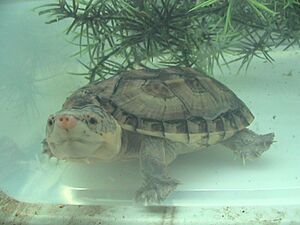Giant musk turtle facts for kids
The giant musk turtle (Staurotypus salvinii), also known as the Chiapas giant musk turtle or the Mexican giant musk turtle, is a type of turtle. It belongs to the family Kinosternidae. You can find this turtle in Central America.
Quick facts for kids Giant musk turtle |
|
|---|---|
 |
|
| Staurotypus salvinii in an aquarium | |
| Conservation status | |
| Scientific classification | |
| Genus: |
Staurotypus
|
| Species: |
salvinii
|
Where it Lives
The giant musk turtle lives in several countries in Central America. You can find it in Belize, El Salvador, Guatemala, and western Honduras. It also lives in Mexico, specifically in the areas of Chiapas and Oaxaca.
Its Home
This turtle likes to live in freshwater places that don't have strong currents. It prefers calm waters like reservoirs and rivers. These places usually have soft bottoms and lots of plants growing in the water.
What's in a Name?
The scientific name for this turtle, salvinii, was given to honor a person. It is named after Osbert Salvin, an English naturalist and herpetologist. A herpetologist is someone who studies reptiles and amphibians.
What it Looks Like
The giant musk turtle is much bigger than most other musk turtles. Its shell can grow up to 38 centimeters (about 15 inches) long. Female turtles are usually quite a bit larger than the males.
These turtles can be brown, black, or green. Their underside is typically yellow. A cool thing about their shell is that it has three clear ridges, or "keels," running along its length. Giant musk turtles are known for being very active and can be quite aggressive.
Unlike many other turtles, the sex of a giant musk turtle is decided by its genes (XX/XY system), not by the temperature of the nest.
What it Eats
Like other musk turtles, the giant musk turtle is a carnivore. This means it eats meat. Its diet includes different kinds of fish, crustaceans (like crabs), smaller turtles, insects, and snails. It also eats dead animals, which is called carrion.
When it catches food, the giant musk turtle opens its mouth very quickly. This creates a strong rush of water that sucks the prey right into its mouth!
Life Cycle
The giant musk turtle reproduces by laying eggs. This means it is oviparous.


